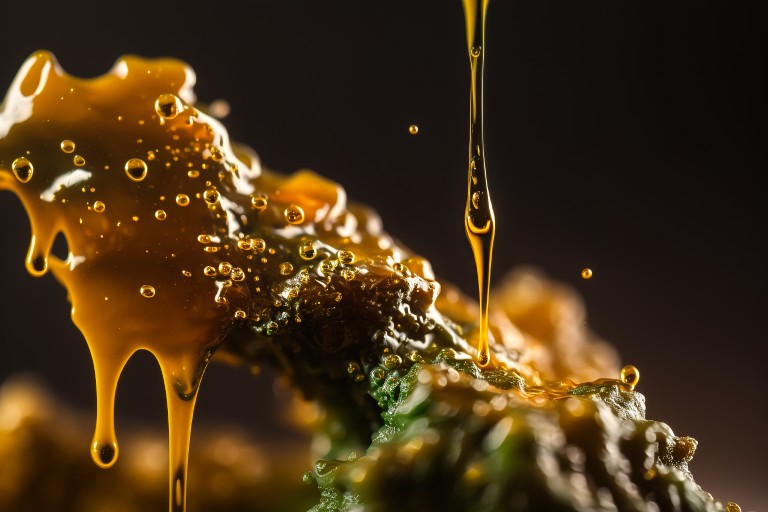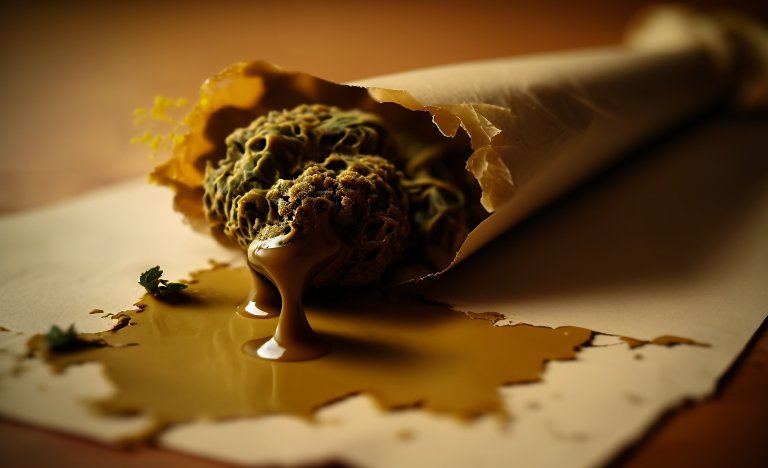- Published on July 24, 2023
Wax, oil, shatter, budder, sauce, rosin, live resin… the varieties of concentrates seem to never end! It can be difficult to know which type to choose based on flavor, effects, and preferred method of consumption, but if you’re consuming for taste there is only one option to consider: live resin.

What is Live Resin?
Live resin is a relatively new form of concentrate, invented in 2013 by master hashmaker William “Kind Bill” Fenger. Soft and pliable in consistency, ranging from golden yellow to white, live resin is known for its potent aroma and flavor and is a favorite among dabbing connoisseurs. Live resin is produced using a specialized extraction process that involves freezing the plant immediately after harvest (aka “fresh frozen’), thereby preserving terpenes which would ordinarily be lost during the extraction of cured plants.
History
This story begins a little over a decade ago in Colorado with Kind Bill. Having grown thousands of pounds of plants in multiple states and made every type of extract under the sun, you could call Fenger a cannabis concentrate expert. Long story short, Bill was harvesting plants one day in Colorado and wondered if he could capture the same freshly-cut smell and smoke it.
After testing numerous methods, he hit roadblock after roadblock. It wasn’t until two years later when he began working with a man known as Giddy Up, founder of EmoTek labs, that he made a significant breakthrough and created the process all live resin producers now follow.
How is it Made?
That process was refined into these six steps and is best left to professionals at a dedicated facility due to the high margin of error. This is not like making rosin with a hair straightener in your garage — live resin production is highly skilled and requires complex, expensive lab equipment.

1. Harvesting
Plants are carefully selected for their desired terpene profile and, ideally, harvested at peak maturity.
2. Flash-Freezing
Immediately after harvest, the cannabis plants are rapidly frozen to extremely low temperatures, typically around -40 degrees Fahrenheit (-40 degrees Celsius). This freezing process helps preserve the volatile terpenes and prevents degradation of both terpenes and chlorophyllic matter.
3. Extraction
Once the plants are frozen, the extraction process begins. Common extraction methods for what is live resin today include hydrocarbon-based methods such as butane or propane extraction. These solvents are used to strip the resinous trichomes from the frozen plant material, capturing the cannabinoids, terpenes, and other desirable compounds.
4. Purging
After the extraction, the solvent is removed from the concentrate through a process called purging. This is usually done using a vacuum oven or a closed-loop system that applies heat and vacuum to evaporate the solvent while leaving behind the concentrated extract.
5. Post-Processing
Depending on the desired consistency, the extracted concentrate may undergo further post-processing steps. This can include processes like winterization, filtration, or dewaxing to remove impurities and undesirable waxes or fats.
6. Packaging
The final live resin concentrate is then packaged and made available for consumption. It is typically stored in airtight containers to preserve its potency and freshness.

How can it be consumed?
Dabbing is a popular method for consuming live resin. It involves using a dab rig, which is a bong designed specifically for smoking concentrates. The live resin is heated on a hot surface, called a banger, and then inhaled through the rig. A banger is a small cup-like reservoir typically made from quartz. It attaches to the bong on the downstem where a bowl would normally be located. This method provides fast and potent effects.
Live resin can also be vaporized using a Puffco-type device specifically designed for concentrates. These devices heat the concentrate at a lower temperature, allowing the terpenes and cannabinoids to vaporize without combustion, offering a smoother and more flavorful experience compared to dabbing.
You can add live resin to flower or roll it into a joint or blunt, enhancing the potency and flavor, or infuse it into various edible products such as gummies, chocolates, or baked goods, providing longer-lasting effects.


Is it full spectrum?
The term “full spectrum” simply refers to any form of cannabis that possesses the wide range of cannabinoid, terpenes, and other beneficial compounds found in the live plant.
Live resin could be considered the most full spectrum cannabis by-product available on the market thanks to the fresh-freezing process, which preserves the volatile cannabinoids and terpenes lost during traditional drying and extraction methods.

Live Resin vs Live Rosin - What is the Difference?
The most glaring difference between live resin and live rosin is the extraction method. While both concentrates are made with fresh frozen raw material, live rosin does not use any solvents to separate the trichomes from plant matter. Live rosin is made with full melt hash, which is made using ice water to isolate the trichomes instead of solvents like with live resin. The hash is then pressed between two gently heated, heavy metal plates to further coax the now-melted trichomes from the remaining plant matter.
Is it worth the price tag?
If flavor and purity are your main priorities as an extract consumer, live resin and live rosin are the creme de la creme. They both boast unmatched taste, produce the smoothest smoke and vapor, as well as provide beneficial trace cannabinoids and terpenes that standard concentrates cannot compete with. However, be prepared to pay a premium for the experience. Live resin can run up to $60/g, while live rosin can easily run double that. You are paying for the expertise as well as time it takes to make the concentrates, but for the level of flavor and impact on overall taste these are worthy investments.
Ultimately, the decision of whether live resin is worth the price tag is subjective and depends on your personal preferences, budget, and desired cannabis experience. If you’re curious about live resin, it may be worth trying a small amount to see if it meets your expectations and justifies the cost for you.
Frequently Asked Questions
It is a relatively new form of concentrate invented in 2013 known for its potent aroma and flavor.
Live Resin production is highly skilled and requires complex, expensive lab equipment. At a high level, it involves 6 common processing steps (Harvesting, Flash Freezing, Extraction, Purging, Post-Processing, Packing)
Dabbing is a popular method for consuming Live Resin and is a favorite among dabbing connoisseurs.
The most glaring difference between Live Resin and Live Rosin is the extraction method and how trichomes are extracted differently.
Related Articles
Vaping 101
Types of Cannabis vaporizers and how to use them
What Are Terpenes
Learn about Terpenes types and effects
How To Clean A Dirty Pipe
Importance of a clean pipe, types of pipes, 5 best ways to clean a pipe

